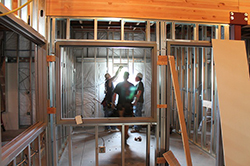 An accounting firm on a building’s top floor accused the roofing contractor of ruining its computer network equipment, even though the contractor wasn’t working on the building at the time. The contractor had finished replacing the roof in September.
An accounting firm on a building’s top floor accused the roofing contractor of ruining its computer network equipment, even though the contractor wasn’t working on the building at the time. The contractor had finished replacing the roof in September.
Heavy snows fell that winter, and it started melting rapidly when March brought above-normal temperatures. The accounting firm’s systems support analyst came in to work on a Monday morning to find pools of water in the server room and the servers inoperable. Given that the first four months of the year are a somewhat busy time for accountants, the firm could not remain without its computer network for long.
It rush-ordered new servers, paid a premium for express shipping, then paid even more to have technicians remove the ruined servers, install the new ones, load the data from backup records kept off site, and perform network testing, all within a period of a few days. The cost to the firm was high, both in terms of repair and replacement costs and extra expenses for its accountants to access an alternative network. The firm sued the building owner and the roofing contractor to recover thousands of dollars in losses.
This is where the contractor’s Completed Operations Liability insurance coverage came in handy. This insurance covers the contractor’s legal liability for bodily injuries or property damage that his work causes after he has finished it. Before the insurance applies, however, the incident must meet several conditions:
-
- The incident must be an “occurrence.” The policy defines this as an accident, but it can also be damage that happens over time because of harmful conditions. The roof suddenly letting melting snow gush all over the servers is an occurrence. So is the roof allowing melted snow to seep into the walls over a period of months, causing plywood and insulation to rot?
-
- It must occur during the policy term. It is not necessary for the contractor’s mistake to happen during the policy term, but the injury or damage must occur then. The contractor finished the roof in September, his liability insurance policy renewed in January, and the damage to the servers occurred in March. The policy that took effect in January applied, not the one in effect in September.
-
- It must occur away from the contractor’s own premises. Liability insurance does not apply to damage to premises the contractor owns or rents.
-
- The injury or damage must arise from the contractor’s work. This means that the contractor’s portion of the job led to the injury or damage. The roof was supposed to keep water out of the building; water entering the building implicates the work done.
-
- The contractor’s work must be completed or abandoned. It’s complete at the earliest of: When all the contract work is complete; when all the work at that job site is complete; or when the customer puts the work to its intended use. The contractor finished the roof in September and the building owner put it to immediate use, so the insurance company will consider it to be complete.
The insurance will not apply to bad work that did not cause damage to something else unless a subcontractor did the job for the contractor. If the building owner discovered the problem with the roof before the accountant’s servers took a shower, the insurance would not apply to fixing the roof. It also doesn’t cover liability for the building becoming unusable or less usable because it contains the contractor’s defective work. Work with one of our insurance agents to ensure that you have the proper coverage. Completed operations losses can be catastrophic; financial protection is essential!






